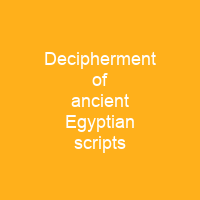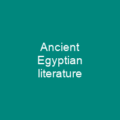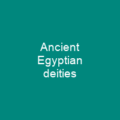Deciphering the Secrets of Ancient Egypt
Imagine a world where the secrets of an ancient civilization lay hidden behind symbols and scripts that no one could read—until Jean-François Champollion and Thomas Young cracked the code in the early 19th century. How did they manage to unlock the mysteries of hieroglyphs, hieratic, and demotic scripts? Let’s dive into this fascinating journey.
The Decline of Understanding
By the fourth and fifth centuries AD, ancient Egyptian writing systems like hieroglyphic, hieratic, and demotic had ceased to be understood. The Coptic alphabet took over as the primary means of communication, but with it came a loss of knowledge about these earlier scripts. Later generations relied on Greek and Roman authors who often misunderstood or misinterpreted them.
The Rosetta Stone: A Key to Decipherment
Enter the Rosetta Stone, discovered in 1799. This stone held the key to deciphering ancient Egyptian writing. Despite early efforts by scholars like Antoine-Isaac Silvestre de Sacy and Johan David Åkerblad, progress was slow until Thomas Young made significant breakthroughs.
How could a single artifact hold so much power?
Champollion’s Breakthrough
Champollion realized that hieroglyphic writing combined phonetic and ideographic elements. His claims were initially met with skepticism but gradually gained acceptance. After Young’s death, Champollion continued to refine his understanding of the scripts, making significant contributions until his own passing in 1832.
How did Champollion manage to decipher a script that had been lost for centuries?
The Evolution of Scripts
Hieroglyphs originated around 3200 BC, primarily used for formal texts. Hieratic and demotic scripts emerged later, with demotic becoming the most common system by the seventh century BC. All three scripts contained a mix of phonetic signs representing sounds and ideographic signs representing ideas.
Can you imagine how complex it must have been to write in such a script?
Theories and Misunderstandings
Many Greek and Roman authors wrote about these scripts, but their understanding was often flawed. For instance, Diodorus Siculus described hieroglyphs as an ideographic script in the first century BC, while Plutarch hinted at the phonetic aspect of hieroglyphs.
How did these misunderstandings affect our understanding of ancient Egypt?
The Decline and Revival
Hieroglyphic writing began to disappear in the third century AD due to the decline of temple-based priesthoods and Egypt’s conversion to Christianity. The last hieroglyphic text was written in 394 AD, while demotic script lasted until 452 AD.
What would ancient Egypt look like today if these scripts had not been deciphered?
The Renaissance and Beyond
In the Renaissance, Europeans became interested in hieroglyphs, recognizing their connection to Coptic. Athanasius Kircher made significant contributions but his work was flawed due to incorrect assumptions.
How did these early efforts shape our modern understanding of ancient Egypt?
The Rosetta Stone and Beyond
The Rosetta Stone’s discovery in 1798 marked a turning point. Jean-Joseph Marcel identified the middle script as ‘cursive characters’ identical to those on papyrus scrolls. Thomas Young made significant progress, proposing a set of phonetic values for hieroglyphic and demotic signs.
What would have happened if the Rosetta Stone had not been discovered?
The Final Decipherment
In 1822, Champollion announced his proposed readings of the Greco-Roman cartouches. He identified dozens of royal names and titles, confirming that phonetic signs were used long before Greek rule in Egypt.
How did Champollion’s work change our understanding of ancient Egyptian history?
The Legacy of Decipherment
Champollion’s system for reading hieroglyphs became applicable to texts from every period of Egyptian history. His work paved the way for a new generation of Egyptologists, including Emmanuel de Rougé and Heinrich Brugsch.
What other secrets might be hidden in ancient scripts waiting to be deciphered?

The decipherment of ancient Egyptian writing systems was a monumental achievement that opened the door to understanding one of history’s most fascinating civilizations. From the Rosetta Stone to Champollion’s groundbreaking work, these efforts have allowed us to uncover the rich tapestry of ancient Egypt’s past.
You want to know more about Decipherment of ancient Egyptian scripts?
This page is based on the article Decipherment of ancient Egyptian scripts published in Wikipedia (retrieved on November 30, 2024) and was automatically summarized using artificial intelligence.







